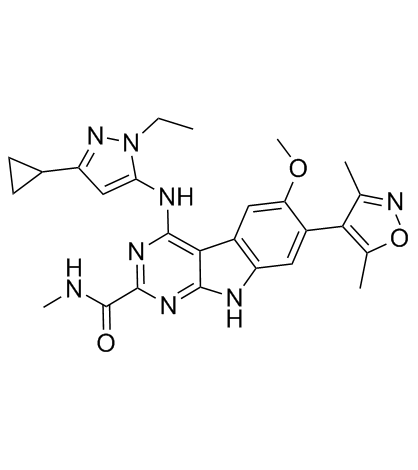HJB97

HJB97 structure
|
Common Name | HJB97 | ||
|---|---|---|---|---|
| CAS Number | 2093391-24-1 | Molecular Weight | 500.55 | |
| Density | N/A | Boiling Point | N/A | |
| Molecular Formula | C26H28N8O3 | Melting Point | N/A | |
| MSDS | N/A | Flash Point | N/A | |
Use of HJB97HJB97 is a high-affinity BET inhibitor with Kis of 0.9±0.2 nM (BRD2 BD1), 0.27±0.09 nM (BRD2 BD2), 0.18±0.01 nM (BRD3 BD1), 0.21±0.03 nM (BRD3 BD2), 0.5±0.2 nM (BRD4 BD1), 1.0±0.1 nM (BRD4 BD2), respectively. HJB97 is a PROTAC BET degrader. Antitumor activity[1]. |
| Name | HJB97 |
|---|
| Description | HJB97 is a high-affinity BET inhibitor with Kis of 0.9±0.2 nM (BRD2 BD1), 0.27±0.09 nM (BRD2 BD2), 0.18±0.01 nM (BRD3 BD1), 0.21±0.03 nM (BRD3 BD2), 0.5±0.2 nM (BRD4 BD1), 1.0±0.1 nM (BRD4 BD2), respectively. HJB97 is a PROTAC BET degrader. Antitumor activity[1]. |
|---|---|
| Related Catalog | |
| Target |
BRD2 BD1:0.9 nM (Ki) BRD2 BD2:0.27 nM (Ki) BRD3 BD1:0.18 nM (Ki) BRD3 BD2:0.21 nM (Ki) BRD4 BD1:0.5 nM (Ki) BRD4 BD2:1.0 nM (Ki) BRD2 BD1:3.1 nM (IC50) BRD2 BD2:3.9 nM (IC50) BRD3 BD1:6.6 nM (IC50) BRD3 BD2:1.9 nM (IC50) BRD4 BD1:7.0 nM (IC50) BRD4 BD2:7.0 nM (IC50) |
| In Vitro | HJB97 is a highly potent and efficacious bomodomain and extra terminal (BET) inhibitor with IC50s of 3.1±0.7 nM (BRD2 BD1), 3.9±0.5 nM (BRD2 BD2), 6.6±0.2 nM (BRD3 BD1), 1.9±0.4 nM (BRD3 BD2), 7.0±0.6 nM (BRD4 BD1), 7.0±0.1 nM (BRD4 BD2). HJB97 potently inhibits cell growth in RS4;11 and MOLM-13 acute leukemia cell lines, which are known to be sensitive to BET inhibitors. HJB97 achieves IC50s value of 24.1±5.3 nM and 25.6±1.9 nM in inhibition of the RS4;11 cell and MOLM-13 cell growth[1]. |
| Cell Assay | RS4;11 and MOLM-13 cells are seeded in 96-well cell culture plates at a density of 10000-20000 cells/well in 100 μL of culture medium. Each compound (e.g.,HJB97; 10-1000 nM) tested is serially diluted in the appropriate medium, and 100 μL of the diluted solution containing the tested compound is added to the appropriate wells of the cell plate. After addition of the tested compound, the cells are incubated for 4 days at 37°C in an atmosphere of 5% CO2. Cell growth is evaluated by a lactate dehydrogenase-based WST-8 assay. The WST-8 reagent is added to the plate, incubated for at least 1 h, and read at 450 nm. The readings are normalized to the DMSO-treated cells, and the IC50 is calculated by nonlinear regression analysis using GraphPad Prism 6 software[1]. |
| References |
| Molecular Formula | C26H28N8O3 |
|---|---|
| Molecular Weight | 500.55 |
| Storage condition | 2-8℃ |